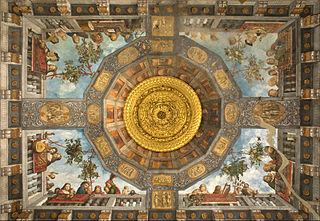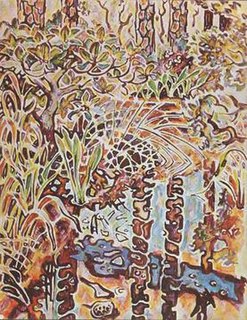Related Research Articles

Trompe-l'œil is an art technique that uses realistic imagery to create the optical illusion that the depicted objects exist in three dimensions. Forced perspective is a comparable illusion in architecture.

Louis Agassiz Fuertes was an American ornithologist, illustrator and artist who set the rigorous and current-day standards for ornithological art and naturalist depiction and is considered one of the most prolific American bird artists, second only to his guiding professional predecessor John James Audubon.

Herbert Kawainui Kāne, considered one of the principal figures in the renaissance of Hawaiian culture in the 1970s, was a celebrated artist-historian and author with a special interest in the seafaring traditions of the ancestral peoples of Hawaiʻi. Kāne played a key role in demonstrating that Hawaiian culture arose not from some accidental seeding of Polynesia, but that Hawaiʻi was reachable by voyaging canoes from Tahiti able to make the journey and return. This offered a far more complex notion of the cultures of the Pacific Islands than had previously been accepted. Furthermore, he created vivid imagery of Hawaiian culture prior to contact with Europeans, and especially the period of early European influence, that sparked appreciation of a nearly forgotten traditional life. He painted dramatic views of war, exemplified by The Battle at Nuʻuanu Pali, the potential of conflicts between cultures such as in Cook Entering Kealakekua Bay, where British ships are dwarfed and surrounded by Hawaiian canoes, as well as bucolic quotidian scenes and lush images of a robust ceremonial and spiritual life, that helped arouse a latent pride among Hawaiians during a time of general cultural awakening.
Ernest Martin Hennings (1886–1956) was an American artist and member of the Taos Society of Artists.

Walter Inglis Anderson was an American painter and writer.
Raymond Ching, also known as Raymond Harris-Ching and Ray Ching, is a New Zealand painter. Ching is known for his contemporary bird and wildlife paintings, and for his ornithological illustrations in books like The Reader's Digest Book of British Birds.

Francisco Eppens Helguera or Francisco Eppens was a Mexican artist known for his paintings, murals and sculptures of images and scenes distinctly Mexican. He also achieved international fame for his award winning modern designs for Mexican postage and revenue stamps (1935–1953) and for his 1968 redesign of the Mexican coat of arms, still used today on Mexican government documents, coins and the national flag.

Charles Robert Knight was an American wildlife and paleoartist best known for his detailed paintings of dinosaurs and other prehistoric animals. His works have been reproduced in many books and are currently on display at several major museums in the United States.
Rudolph Franz Zallinger was an American-based Austrian-Russian artist. His most notable works include his mural The Age of Reptiles (1947) at Yale University's Peabody Museum of Natural History, and the March of Progress (1965) with numerous parodies and versions. His painting of a Tyrannosaurus heavily influenced the creature design of Toho Studios' Godzilla (1954). Two of Zallinger's dinosaurs - the T. rex and Brontosaurus - are seen in that film as part of a slide demonstration during a lecture in the National Diet Building.

Charles Fracé was an American wildlife artist whose work was featured in more than 500 exhibitions, including a solo exhibition at the National Museum of Natural History of the Smithsonian Institution in Washington, D.C. Fracé painted over a hundred paintings from which limited edition prints were produced, which were consistently popular with collectors.
Don Balke is an American artist. He is best known for his watercolor wildlife art and scenic oil paintings.
Clarence Tillenius, was a Canadian artist, environmentalist, and advocate for the protection of wildlife and wilderness.
Guy Coheleach is an American wildlife artist. His paintings have been in 41 one-man retrospective exhibitions in major museums in 36 cities from New York to Los Angeles from 1991 to 2011. Along with over a hundred one-man commercial shows worldwide, his work has also been exhibited in the National Collection of Fine Art, the Royal Ontario Museum, the White House, Washington D.C.'s Corcoran Gallery, the Norton Gallery and the Newark Museum.
Terry Isaac was an American painter from Salem, Oregon who was known for his realism paintings of wildlife. In 2007, he moved to Canada.
Joy Postle was a pioneering American environmental artist and creator of celebrated murals depicting Florida wildlife.

Alexander Pope Jr. was an American artist, both in paint and wood carving, mostly of sporting and still life subjects. He was born in Dorchester, Massachusetts and died in Boston, Massachusetts. He studied for a short time under the sculptor William Copley, and was one of America's popular gaming artists.

Walter William Ferguson was born in New York City in 1930 and died in 2015. He received his formal art training under scholarship at Yale School of Fine Arts and Pratt Institute. He has exhibited widely in Israel and abroad and his paintings are in many private collections.
Richard Sloan (1935–2007) was an American artist. He painted wildlife in Arizona and in rainforests.

Frank Armitage was an Australian-born American painter and muralist, known for painting the backgrounds of several classic animated Disney films, designing areas of and painting murals for Walt Disney World and Tokyo DisneySea, and his biomedical visualization artwork.

Patrick Ching (born c. 1963) is a Hawaiian conservationist and wildlife artist, ornithological illustrator, and author of children's books.